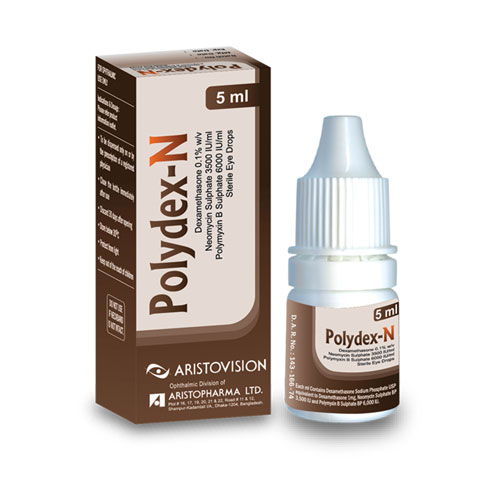
POLYDEX- N Eye drops
Therapeutic Class
Antibiotic & Steroid
Indications
Polydex-N is indicated in ocular inflammation when concurrent use of an antimicrobial is judged necessary.
Chemical Composition
Polydex-N Sterile Eye Drops: Each ml contains Dexamethasone 0.1%, Neomycin Sulphate 3,500 I.U., Polymyxin B Sulphate 6,000 I.U.
Polydex-N Sterile Eye Ointment: Each g contains Dexamethasone 0.1%, Neomycin Sulphate 3,500 I.U. and Polymyxin B Sulphate 6,000 I.U.
Packaging
Polydex-N Sterile Eye drops: Each plastic dropper contains 5 ml eye drops. Polydex-N Steriel Eye Ointment: Each tube contains 3 gm eye ointment.
Dosage & Administration
Eye drops: One drop topically into the conjunctival sac(s). In severe disease, drops may be used hourly, being tapered to discontinuation as the inflammation subsides. In mild disease, drops may be used up to four to six times daily. Eye ointment: It should be applied thinly and evenly to the conjunctival sac(s) at night (if eye drops used during the day) or 3-4 times daily (if eye ointment used alone).
Contraindications
Epithelial herpes simplex keratitis (dentritic keratitis), vaccinia, varicella, and many other viral diseases of the cornea and conjunctiva. Hypersensitivity to a component of the medication (Hypersensitivity to the antibiotic component occurs at a higher rate than other component). The use of these combinations is always contraindicated after uncomplicated removal of a corneal foreign body.
Side Effects
Adverse reactions have occurred with steroid/anti-infective combination drugs which can be attributed to the steroid component, the anti-infective component, or the combination. Exact incidence figures are not available since no denominator of treated patients is available. Reactions occurring most often from the presence of the anti-infective ingredient are allergic sensitizations. The reactions due to the steroid component in decreasing order of frequency are: elevation of intraocular pressure (IOP) with possible development of glaucoma, and infrequent optic nerve damage, posterior sub-capsular cataract formation and delayed wound healing.

